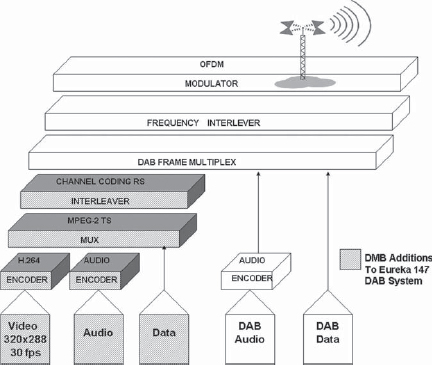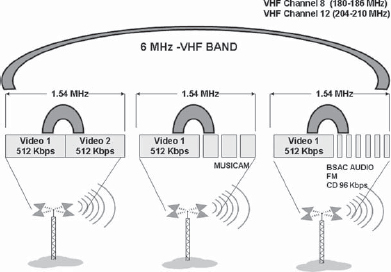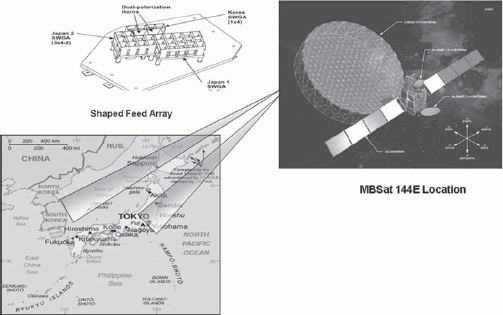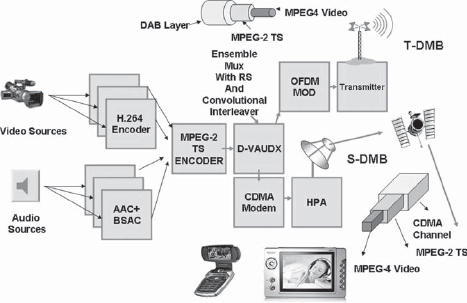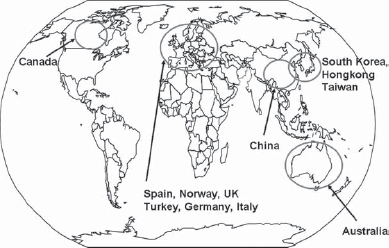MOBILE TV USING DIGITAL MULTIMEDIA BROADCAST (DMB) SERVICES
Nothing can have value without being an object of utility.
—Karl Marx
8.1 INTRODUCTION TO DMB SERVICES
A new era began in May 2005 when world’s first broadcast mobile TV services went live in Korea with the launch of S-DMB services. The T-DMB services were soon to follow, being launched in December 2005. The DMB services were the culmination of many years of work in designing of protocols, air interfaces, and chip sets, which would enable the broadcasting of multimedia to mobile devices. Prior to this the only unicast mobile TV was available through 3G networks with their attendant constraints. The T-DMB services also preceded the DVB-H services in terms of launch in commercial networks. Digital mobile multimedia broadcast services, as the name suggests, comprise broadcast of multimedia content, including video, audio, data, and messages to mobile devices. These services, unlike the 3G mobile services, which are based on unicast of data (with the exception of MBMS, which is multicast), are provided by broadcasting of the content and hence have the capability to service an unlimited number of users. The services had their origin in Korea and Japan and are provided by using both the terrestrial mode of transmission and the satellite mode. The initiative for the development of DMB services came from the Ministry of Information and Communications (MIC) of Korea, who assigned the Electronics and Telecommunications Research Institute (ETRI) of Korea to develop a system for broadcast of mobile TV. The standards of S-DMB and T-DMB, which were formulated subsequently, received ETSI approval, paving the way for launches outside of Korea. The S-DMB services were provided by TuMedia, which was founded by Korea Telecom, while the T-DMB services in Korea were licensed to multiple broadcasters.
DMB services are based on an enhancement of the DAB (digital audio broadcast standard), which has been in use worldwide for radio broadcasts. The DMB standards use the physical layer, air interfaces, and multiplex structure of DAB to carry MPEG-2 transmit streams, which serve as conduits of audio and video data coded in MPEG-4 or other standards. The DAB standards were designed for delivery of CD-quality audio anywhere on the move. The technology used MPEG-1 Layer 2 MUSICAM and the audio service is provided at a data rate of 384 kbps. The robust design of DAB and availability of spectrum were the primary reasons for an enhancement of the DAB standards to also carry video. The modified standards were formalized under DMB. The new standards have been standardized by the ETSI under ETSI TS 102 427 and TS 102 428. However, it should be recognized that many of the specifications under the DMB standard remain proprietary, with intellectual property rights (IPRs) held by Korean companies.
Mobile TV services using the DMB and DAB-IP technology have been launched in Germany, France, and the United Kingdom and are under implementation in many countries. The DAB, DMB, and DAB-IP services are fundamentally similar in nature as they share the same spectrum, protocols, and infrastructure.
8.2 A BRIEF OVERVIEW OF DAB SERVICES
The DAB services had their origin in the year 1987 with the formalization of the Eureka 147 Project. The standard for DAB services was formulated as a European standard in 1993 and as an ITU-R standard in 1994. DAB envisages the use of VHF, UHF, L-band or the S-band.
The DAB services are organized as “ensembles.” Each ensemble is a multiplexed stream of audio and data and occupies approximately 1.55 MHz after orthogonal frequency division multiplexing (OFDM) modulation. Each ensemble can carry 1.5 Mbps of data based on the parameters selected for OFDM modulation. Where the capacity is provided in a typical 6-MHz broadcast “slot,” the 6 MHz can carry three independent ensembles. This bandwidth of 1.5 Mbps is adequate for five channels of CD-quality programs running at 256 kbps each. The codec used is MPEG-2 Layer 2 MUSICAM. Over time DAB has become a well-established service and the technologies of OFDM transmission and single-frequency networks (SFN) have proved quite robust. The service can be received by a large range of devices, both car mounted and handheld.
8.3 HOW IS THE DAB STRUCTURE MODIFIED FOR DMB SERVICES?
The DAB frame consists of a multiplex of audio services that are carried at a constant bit rate (also called the stream mode). The frame is generated by an ensemble multiplexer, which assembles the various audio services, assigning a fixed bit rate to each and providing the multiplex information in the frame header, which also carries the synchronization information. It can also carry data from one or more sources, in which case a variable rate of data carriage is offered through packet switching (Fig. 8-1).
In the DAB scheme the bandwidths allotted to stereo channels are quite wide, i.e., 256 kbps for MUSICAM. This was seen as an opportunity for replacing audio with multimedia channels (audio and video) using encoders with higher efficiency such as MPEG-4 or H.264 for video and AAC-HE or AAC+ for audio. This was done by modifying the DAB standards to DMB standards. In DMB, in addition to the carriage of multimedia in the available bandwidth, it was felt desirable to add an additional layer of coding and convolutional interleaving to give greater forward error correction capability, which is necessary for mobile environments. The ensemble multiplexer of DAB does not carry program information such PAT (Program Association Table), which is needed to identify all the streams of video, audio, and data (such as subtitling) associated with a particular program. This was resolved by maintaining the MPEG-2 transport frame structure as a “pipe” to channel programs into the ensemble multiplexer. The broadcasting world is very familiar with the MPEG-2 transport structure and this requires minimal changes on the broadcaster’s side. Consequently the DMB standards have evolved from DAB by letting the ensemble multiplexer (which provides a fixed bit rate or stream mode) carry MPEG-2 transmit streams, which in turn contain multiple programs coded in MPEG-4 or other protocols (Fig. 8-2).
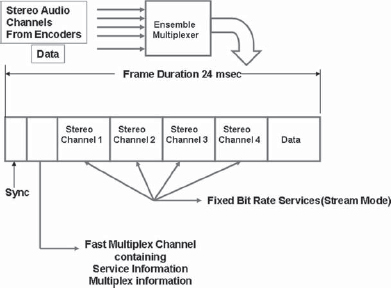
FIGURE 8-1 DAB Frame Structure
The use of the conventional MPEG-2 transmit stream (TS) also meant that the broadcast level conditional access could be applied with only minor modifications.
Once the frame structure was finalized, the only other addition was the additional RS coding and convolutional interleaving, which was applied to the MPEG-2 transport streams to complete the structure of DMB as they operate today. DMB uses RS(204,188) coding and Forney interleaving for additional error protection. The additional error resilience was built into the multimedia streams to overcome the transmission impairments encountered in the mobile environment. The overall protocol structure of the DMB is at considerable variance with the DVB-H, which is based on the IP datacasting of streams of encoded audio, video, and data. The DMB standards on the other hand use the DVB-ASI formats of streams generated by the encoders, which are multiplexed together in an ensemble multiplex. The protocol stacks on which DVB-H services are built are essentially built around the capability of the IP datacasting layer and include RTP streaming, FLUTE file transfer, HTML/XML, etc. The IP layer also gives the DVB-H the capability of transmitting data carousels using FLUTE. On the other hand the DMB standards do not use an IP transport layer, as is the case in DVB-H, but rather rely on the MPEG-2 TS structure carried within the DAB ensemble multiplexer. DMB does not also use any time-slicing scheme for saving of power. Figure 8-3 shows the DMB system architecture including the enhancements done for DMB over the DAB Eureka 147 system. DMB instead uses the MPEG SL layer for synchronization and BIFS for additional program-associated data.
FIGURE 8-2 Evolution of DMB Services Based on DAB Frame Structure
Transmission Modes in DAB

The DAB system is characterized by four modes of transmission based on the frame duration and the number of carriers (Table 8-1). It is evident that the VHF band (in mode I) and L-bands (in mode IV) provide the best combination of SFN range and mobility (Fig. 8-4).
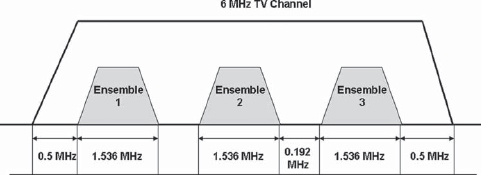
FIGURE 8-4 T-DMB Ensembles in 6–MHz Band
The ensembles in DMB continue to serve the same function as in DAB with the addition that each of the services in an ensemble is error protected. The overall error protection works out to be quite robust with FEC overheads ranging from 200 to 300%.
8.4 SATELLITE AND TERRESTRIAL DMB SERVICES
Mobile multimedia broadcast services under the DMB umbrella are available for satellite-based delivery (S-DMB) and terrestrial digital multimedia broadcast (T-DMB).
Satellite multimedia broadcast service, in the case of Korea and Japan, uses the high-power satellite MBSAT operating in the S-band (2630– 2655 MHz). The spectrum used by S-DMB is the same as that of digital audio broadcasting, which has been allocated by the ITU and hence is available in most countries. The satellite transmissions in the S-band directly to mobiles are possible through the use of the specially designed high-power satellite MBSAT, which has footprints over the major cities of Korea and Japan. The satellite services needs to use gap fillers for coverage of indoor areas and where the satellite signal strength is not adequate.
Despite the high power of the satellite signals, direct reception by mobiles requires more robust techniques for error protection and resilience against transmission conditions. S-DMB uses modulation similar to that of CDMA as opposed to multicarrier OFDM for terrestrial transmissions (System E in Korea). The 25 MHz available on the satellite is then sufficient to provide 11 video channels, 30 audio channels, and up to 5 data channels for delivery over the entire country. The video is carried at 15 fps against 30 fps in T-DMB.
S-DMB and T-DMB Characteristics
The terrestrial digital multimedia services, on the other hand, are based on the use of the VHF spectrum, which, in the case of Korea, was reserved for such services. T-DMB services can in fact operate in the VHF, UHF, or other bands such as L- or S-bands, depending on availability. A6-MHz analog TV channel slot can carry seven or eight video channels (CIF), 12 audio, and up to 8 data channels in a typical operating environment.
The DMB standards compete with the DVB-H standards, which are based on terrestrial transmission in the VHF/UHF bands to mobile devices (Table 8-2).
8.5.1 Terrestrial DMB Services
Terrestrial DMB services were planned in Korea by the ETRI, which was mandated by the MIC of Korea to provide TV transmission for mobile devices. The standard selected was a modification of the Eureka 147 standard for digital audio broadcasting. The plans for the launch of the T-DMB service, including the standards and spectrum to be used, were finalized in 2003.
The purpose was to be able to provide CD-quality stereo audio and VCD-quality video (CIF or QVGA) at 15–30 fps to handheld mobile sets or other mobile devices.
For this purpose two VHF channels were identified, i.e., channel 8 and channel 12 of the VHF band. Each channel was to be divided into three slots (i.e., three digital channels per analog VHF bandwidth slot) so as to enable up to six T-DMB broadcasters to provide such services. Owing to the subdivision of the 6-MHz band into three slots of 1.54 MHz each and the requirements of the guard band, the gross data rate per digital channel works out to 1.7 Mbps and the usable data rate is around 1.2 Mbps. Accordingly, each provider needs to divide 1.2 Mbps into several audio and video channels. By applying MPEG-4 Part10 Advanced Video Coding (AVC) (H.264), a cutting-edge compression technology with better compression efficiency, as standard, two to three television channels can be accommodated, or one television channel and several audio and data channels can be accommodated in one ensemble multiplex (Fig. 8-5).

FIGURE 8-6 Terrestrial DMB Phones (Picture Courtesy of LG)
The T-DMB services are provided standard high-power VHF transmitters with 1–2 kW of emission power. This obviates the need for gap fillers for most locations except tunnels, etc. (Fig. 8-6).
The basic requirements, which were set out at the time of planning of DMB services, were to provide a video service with CIF (352 × 288) resolution at 30 fps and CD-quality stereo audio with 48 kHz sampling. The terrestrial DMB services rely on the use of terrestrial transmitters, but also rely on gap fillers for transmission inside subways, malls, and areas not served well by the terrestrial transmitters. The T-DMB services began in December 2005 and are being provided free of charge at present in Korea.
There are currently six permitted broadcasters—KBS, MBC, SBS, YTN, Korea DMB Co., and U1 Media. The services being provided by two of the broadcasters are as follows:
• KBS (Korean Broadcasting System): video (CIF 352 × 288) at 30 fps and BSAC audio at 48 kHz/128 kbps stereo.
• SBS (Seoul Broadcasting System): video QVGA at 15 fps and BSAC audio at 48 kHz/128 kbps stereo.
8.5.2 T-DMB Standards
Highlights of T-DMB standards followed in Korea are given in Table 8-3. T-DMB standards have been approved by ETSI and were at an advanced stage of approval by ITU in 2006. The technology of DAB, which is the physical transmission layer, has already been tested widely and is in use in a number of countries.
Highlights of T-DMB Standards
Video coding |
H.264 (MPEG-4/AVC Part 10) baseline profile at level 1.3 |
Audio coding |
MPEG-4 Part 3 BASC audio (bit sliced arithmetic coding) |
Multiplexing |
M4 on M2 (MPEG-2 TS carrying MPEG-4 SL) |
Channel coding |
Reed Solomon with convolutional interleaving |
Transmission layer |
DAB (Eureka 147 (stream mode)) |
Aux data |
MPEG-4 BIFS core 2D profile |
The T-DMB standards make use of efficient compression algorithms under H.264 and thus permit the carriage of even VCD-quality video at 352 × 288 resolution at a full frame rate of 30 fps. The audio is coded at 96 kbps for MUSICAM as against 384 kbps under the DAB.
Video for T-DMB standard, where higher resolution is required (i.e., more than QCIF or QVGA), is coded with the resolution of 640 × 480 (VGA quality) with 30 fps using H.264 (MPEG-4/AVC) codecs. The profile used is baseline profile at level 1.3. The coding of audio (CD-quality stereo audio) uses MPEG-4 ER-BSAC.
In addition, auxiliary data (e.g., text and graphic information) can be transmitted using MPEG-4 BIFS specifications. The specifications also cover the carriage of legacy DAB services such as CD-quality audio (DAB MUSICAM) and slide show/interactive services using the BWS EPG protocols. At the same time it also provides for upgrades to this technology. Whereas the standard DAB MUSICAM is carried at 384 kbps, using the optional higher compression codec, it is possible to carry it at 96 kbps. Slide shows can be carried using MPEG-4 BIFS format.
While the T-DMB services do not have the feature of time slicing (as DVB-H has), the fact that they deal with lower frequency transmissions with a lower bandwidth of 1.55 MHz for a given carrier helps keep the tuner power low. The launch of T-DMB services in Korea was preceded with considerable work in the development of chip sets, handsets, and technologies to launch the services. LG and Samsung have been active partners in the launch of T-DMB services, which have been launched as free-to-air.
FIGURE 8-7 Data Telecast via DMB Can Provide Interactive Services
T-DMB services in Korea are also characterized by a high level of interactivity provided through services such as traffic and traveler information, television mobile commerce, and audio–video synchronized data (Fig. 8-7). The chip sets developed have the capability of return channels via CDMA networks widely used in Korea or via GPRS, EDGE, Wi-Fi, or WiBro networks. The technology of MPEG-4 BIFS and the use of middleware such as Java and Brew have been helpful in presenting applications with animations and graphics enhancing their user appeal.
8.5.3 Satellite DMB Services
Satellite DMB services in Korea had their origin in the planning and launch of a specialized high-powered S-band spot beam satellite (MBSAT) for video, audio, and data services (Fig. 8-8). The satellite was designed specifically to provide coverage of Korea and Japan while avoiding interference to other countries through the use of a 12-m offset paraboloid offset reflector. The beam in the shape of the territories covered was achieved using a multielement feed array. The large reflector satellite along with the high-power electronics delivers high effective isotropic radiated power (EIRP) of 67dBw, which enables handheld mobiles to receive the signals directly. Areas inside buildings and in subway tunnels, etc., are covered using gap fillers, which also operate in the S-band. Just for the purposes of comparison, it is interesting to note that the Ku band direct to home systems using the FSS band uses an EIRP of around 52 dBw in conjunction with 60-cm receiver dishes. The BSS band satellites such as Echostar have an EIRP of 57dBw. The EIRP of 67 dBw is 10 dB higher than the highest powered Ku band systems, i.e., a power level that is 100 times higher. This satellite is somewhat unique in this regard and hence S-DMB-type services elsewhere in the world would depend upon the availability of such high-powered specially designed satellites. The S-band geostationary satellite is jointly owned by MBCo Japan and SK Telecom of Korea and is manufactured by SS/Loral based on the FS-1300 bus.
FIGURE 8-8 MBSAT for S-DMB Services
8.5.4 Transmission System
The technical system for satellite DMB services is designated as System E (ITU-R BO.1130-4) and is based on CDMA modulation. However, this interface is not identical to the CDMA used in 3G phones. The transmission system has been designed for Ku-band uplink and S-band downlink. The mobile transmission systems use the code division multiplexing scheme with interleaving RS coding and forward error correction systems. The satellite signals, however strong, cannot reach deep inside buildings, tunnels, and other covered spaces and a range of gap fillers have been developed to retransmit the signals in the S-band. The gap fillers receive their signals from the Ku-band transmission of the satellite (Fig. 8-9).

FIGURE 8-9 MBSAT Mobile Broadcasting System
The satellite S-band transmissions (direct to the mobiles) are in the frequency band 2.630 to 2.655 GHz with a bandwidth of 25 MHz. The use of a high level of error protection, however, allows a transmission capacity of 7.68 Mbps. This is sufficient to handle 15 video services and a mix of audio and data services.
For the coverage of indoor areas the S-band repeaters receive signals from the satellite in the Ku band at 12.214 to 12.239 GHz. The dual coverage of satellite and terrestrial repeaters ensures that the signals can be received in metropolitan areas, which are characterized by tall buildings, tunnels, and obstacles that prevent a direct line of sight to the satellite.
FIGURE 8-10 Mobile TV Transmission Ground Segment in T-DMB
The launch of the Korean DMB services in S-DMB format followed by T-DMB placed it in the category of countries that are keen to adapt innovative technologies.
8.6 DMB SERVICES GROUND SEGMENT
The ground segment of a DMB station (Fig. 8-10) would typically aggregate, from a number of sources (or different broadcasters), video, which would be encoded using MPEG-4 or H.264, and audio, coded as AAC+ or BSAC. The following are the basic parameters:
• video—MEPG-4/AVC (H.264),
• audio—MPEG-1/2 Layer I/II or BSAC/AAC.
The encoder outputs (ASI) would then be placed in an MPEG-2 TS framework and have all parameters assigned to them such as PAT, PMT, and electronic service guide. The service would also be encrypted at this stage by a CA system (such as Irdeto Mobile, used in Korea S-DMB). The MPEG-2 stream is then placed in a DAB layer after the RS coding and convolutional interleaving, which is carried out in a unit called D-VAUDX. The signal stream is then OFDM modulated and transmitted. In the case of DVB-S, instead of OFDM transmission a CDMA modulation is used.
8.7 S-DMB SYSTEM SPECIFICATIONS
The S-DMB system follows the following specifications:
1. Compression layer
• Video: H.264/MPEG-4 Part 10 AVC baseline profile at Level 1.3
• Audio: MPEG-2AAC+
• Auxiliary data: MPEG-4 BIFS Core 2D profile
2. Multiplexing layer: M4 on M2
• MPEG-4 SL
• MPEG-2 TS (PES)
3. Channel coding layer
• Reed–Solomon coding (204,188)
• Convolution interleaving
• BER performance: less than 10-8
4. Transmission layer
• DAB (Eureka 147)
The MPEG-4-encoded audio and video streams are then multiplexed into an MPEG-2 TS. This a variation from the Eureka 147 system and is primarily done to improve the error protection and resilience to transmission errors using the RS coding and convolution interleaving, which is applied to the MPEG-4 TS.
8.8 DMB TRIALS AND SERVICE LAUNCHES
The DMB services have witnessed trials in over 11 countries and all indications are that the services will see strong growth despite considerable focus on DVB-H by broadcasters and some handset manufacturers (Fig. 8-11).
After the launch of services in Korea, the next major milestone was the trial launch of services in Germany, Italy, and Finland using the T-DMB technologies (prior to the FIFA World Cup 2006). The German trial involved the broadcaster MFD (Mobiles Fernsehen Deutschland) in cooperation with T-Mobile and the services were based on a T-DMB offering. Mobile TV services based on T-DMB were available in six cities in Germany by the end of 2007.
FIGURE 8-11 T-DMB Trials and Commercial Launches
China’s DMB services are being launched by three operators. The Chinese DMB standard is their own version of T-DMB, which features the COFDM Chinese standard. The standard is called DVB-T/H and has been developed by Tsinghua University in Beijing and Jiaotong University in Shanghai. The standard has both a single carrier and a multicarrier option. The service is supported in both VHF and UHF bands with 8-MHz channel spacing. In this respect it differs considerably from the T-DMB standard of Korea, where narrow channels of 1.54 MHz each are used.
T-DMB services in France are being launched with the cooperation of the mobile operator Bouygues Telecom and TV broadcaster TF1 and VDL. VDL has been providing DAB services in France since 1998. Bouygues Telecom has been providing i-mode services in France since 2002 and operates an EDGE network. The handsets for the service are being provided by Samsung.


